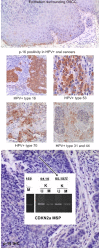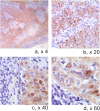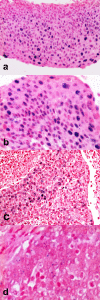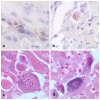Evaluation of a combined triple method to detect causative HPV in oral and oropharyngeal squamous cell carcinomas: p16 Immunohistochemistry, Consensus PCR HPV-DNA, and In Situ Hybridization
- PMID: 22376902
- PMCID: PMC3313884
- DOI: 10.1186/1750-9378-7-4
Evaluation of a combined triple method to detect causative HPV in oral and oropharyngeal squamous cell carcinomas: p16 Immunohistochemistry, Consensus PCR HPV-DNA, and In Situ Hybridization
Abstract
Background: Recent emerging evidences identify Human Papillomavirus (HPV) related Head and Neck squamous cell carcinomas (HN-SCCs) as a separate subgroup among Head and Neck Cancers with different epidemiology, histopathological characteristics, therapeutic response to chemo-radiation treatment and clinical outcome. However, there is not a worldwide consensus on the methods to be used in clinical practice. The endpoint of this study was to demonstrate the reliability of a triple method which combines evaluation of: 1. p16 protein expression by immunohistochemistry (p16-IHC); 2. HPV-DNA genotyping by consensus HPV-DNA PCR methods (Consensus PCR); and 3 viral integration into the host by in situ hybridization method (ISH). This triple method has been applied to HN-SCC originated from oral cavity (OSCC) and oropharynx (OPSCC), the two anatomical sites in which high risk (HR) HPVs have been clearly implicated as etiologic factors. Methylation-Specific PCR (MSP) was performed to study inactivation of p16-CDKN2a locus by epigenetic events. Reliability of multiple methods was measured by Kappa statistics.
Results: All the HN-SCCs confirmed HPV positive by PCR and/or ISH were also p16 positive by IHC, with the latter showing a very high level of sensitivity as single test (100% in both OSCC and OPSCC) but lower specificity level (74% in OSCC and 93% in OPSCC).Concordance analysis between ISH and Consensus PCR showed a faint agreement in OPSCC (κ = 0.38) and a moderate agreement in OSCC (κ = 0.44). Furthermore, the addition of double positive score (ISHpositive and Consensus PCR positive) increased significantly the specificity of HR-HPV detection on formalin-fixed paraffin embedded (FFPE) samples (100% in OSCC and 78.5% in OPSCC), but reduced the sensitivity (33% in OSCC and 60% in OPSCC). The significant reduction of sensitivity by the double method was compensated by a very high sensitivity of p16-IHC detection in the triple approach.
Conclusions: Although HR-HPVs detection is of utmost importance in clinical settings for the Head and Neck Cancer patients, there is no consensus on which to consider the 'golden standard' among the numerous detection methods available either as single test or combinations. Until recently, quantitative E6 RNA PCR has been considered the 'golden standard' since it was demonstrated to have very high accuracy level and very high statistical significance associated with prognostic parameters. In contrast, quantitative E6 DNA PCR has proven to have very high level of accuracy but lesser prognostic association with clinical outcome than the HPV E6 oncoprotein RNA PCR. However, although it is theoretically possible to perform quantitative PCR detection methods also on FFPE samples, they reach the maximum of accuracy on fresh frozen tissue. Furthermore, worldwide diagnostic laboratories have not all the same ability to analyze simultaneously both FFPE and fresh tissues with these quantitative molecular detection methods. Therefore, in the current clinical practice a p16-IHC test is considered as sufficient for HPV diagnostic in accordance with the recently published Head and Neck Cancer international guidelines. Although p16-IHC may serve as a good prognostic indicator, our study clearly demonstrated that it is not satisfactory when used exclusively as the only HPV detecting method. Adding ISH, although known as less sensitive than PCR-based detection methods, has the advantage to preserve the morphological context of HPV-DNA signals in FFPE samples and, thus increase the overall specificity of p16/Consensus PCR combination tests.
Figures





Similar articles
-
Inclusion of an E7 DNA Amplification Test Improves the Robustness of Human Papillomavirus-Associated Oropharyngeal Squamous Cell Carcinoma Diagnosis.World J Oncol. 2020 Feb;11(1):1-8. doi: 10.14740/wjon1243. Epub 2020 Feb 2. World J Oncol. 2020. PMID: 32095184 Free PMC article.
-
Incorporation of Cervista Human Papillomavirus 16/18 Assay Into Algorithms for Classifying Human Papillomavirus Status in Formalin-Fixed, Paraffin-Embedded Head and Neck Squamous Carcinoma Specimens.Arch Pathol Lab Med. 2019 Mar;143(3):356-361. doi: 10.5858/arpa.2017-0469-OA. Epub 2018 Sep 17. Arch Pathol Lab Med. 2019. PMID: 30221979
-
The role of human papillomavirus in p16-positive oral cancers.J Oral Pathol Med. 2018 Jan;47(1):18-24. doi: 10.1111/jop.12649. Epub 2017 Oct 30. J Oral Pathol Med. 2018. PMID: 29024035
-
Challenges and Considerations in Diagnosing and Managing p16+-Related Oropharyngeal Squamous Cell Carcinoma (OPSCC) with Neck Metastasis: Implications of p16 Positivity, Tobacco Exposure, and De-Escalation Strategies.J Clin Med. 2024 Nov 11;13(22):6773. doi: 10.3390/jcm13226773. J Clin Med. 2024. PMID: 39597917 Free PMC article. Review.
-
HPV as a marker for molecular characterization in head and neck oncology: Looking for a standardization of clinical use and of detection method(s) in clinical practice.Head Neck. 2019 Apr;41(4):1104-1111. doi: 10.1002/hed.25591. Epub 2019 Feb 12. Head Neck. 2019. PMID: 30747478 Review.
Cited by
-
Human Papillomavirus-Related Non-Metastatic Oropharyngeal Carcinoma: Current Local Treatment Options and Future Perspectives.Cancers (Basel). 2022 Nov 1;14(21):5385. doi: 10.3390/cancers14215385. Cancers (Basel). 2022. PMID: 36358801 Free PMC article. Review.
-
Equivocal p16 immunostaining in squamous cell carcinoma of the head and neck: staining patterns are suggestive of HPV status.Head Neck Pathol. 2012 Dec;6(4):422-9. doi: 10.1007/s12105-012-0382-3. Epub 2012 Jul 17. Head Neck Pathol. 2012. PMID: 22801997 Free PMC article.
-
Loco-Regional Control and Sustained Difference in Serum Immune Protein Expression in Patients Treated for p16-Positive and p16-Negative Head and Neck Squamous Cell Carcinoma.Int J Mol Sci. 2023 Feb 14;24(4):3838. doi: 10.3390/ijms24043838. Int J Mol Sci. 2023. PMID: 36835246 Free PMC article.
-
HPV and Other Risk Factors Involved in Pharyngeal Neoplasm-Clinical and Morphopathological Correlations in the Southwestern Region of Romania.Pathogens. 2023 Jul 27;12(8):984. doi: 10.3390/pathogens12080984. Pathogens. 2023. PMID: 37623944 Free PMC article.
-
Human papillomavirus (HPV) and Epstein-Barr virus (EBV) in keratinizing versus non- keratinizing squamous cell carcinoma of the oropharynx.Infect Agent Cancer. 2018 Nov 9;13:32. doi: 10.1186/s13027-018-0205-6. eCollection 2018. Infect Agent Cancer. 2018. PMID: 30455727 Free PMC article.
References
LinkOut - more resources
Full Text Sources
Research Materials
Miscellaneous

